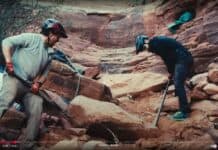By Alison Ecklund
Larson Newspapers
Every year, the Association of Public Safety Communications Officials honors emergency dispatchers during National Public Safety Telecommunications Week, April 12 through 18.
Sedona’s Public Safety Answering Point is one of only two in the country run by the fire department instead of the police department.
That means any 9-1-1 call coming in from the area automatically goes to Sedona Fire District’s regional communication center in Uptown. Since the center dispatches for 12 other fire and medical agencies, SFD’s dispatch receives calls from almost 100 miles of Interstate 17.
Criminal 9-1-1 calls, that don’t need fire or medical service, are dispatched from the regional communication center to Sedona Police Department’s dispatch center.
SFD’s regional communication center handles an average of 8,000 calls a month — 2,000 are 9-1-1 calls — dispatching for agencies from Sedona, Montezuma/Rimrock, Camp Verde, Cottonwood, Verde Valley Fire District, Verde Valley Ambulance Company, Pinewood, Mayer, Black Canyon City and Yavapai Apache Nation.
An advantage to regional dispatch is that it allows the technological sophistication and high quality equipment that none of the agencies could afford on their own.
SPD’s dispatch, which receives criminal 9-1-1 calls that go in to SFD’s dispatch center, receives an average of 1,228 9-1-1 calls a month.
Traffic is the most popular topic from callers, SPD dispatcher Johnna Johnson said. People call 9-1-1 if they see someone speeding, see a likely DUI or see a cigarette flicked out the window.
When officers stop a car, it’s the dispatchers who run the license plate
immediately, to check registration and let the officer know if it’s a stolen car.
After the officer makes contact with the driver, the dispatcher runs the driver’s license to check for wants and warrants, and suspended licenses.
As a stay-at-home mom, Johnson decided to reenter the workforce but only if she felt she was contributing to something good.
Her job is stressful, she admits, but she enjoys it and doesn’t have any secrets for dealing with answering the phone on the caller’s worst day.
“There’s very little that shocks me anymore,” Johnson said.
One call etched in her memory was from December 2002, when she dispatched officers to a suspicious person in a bank.
When a sergeant arrived, he was confronted by two suspects who jumped in a car and ran him over twice.
“From there it grew,” Johnson said. “I had two armed suspects, they were in a stolen vehicle, they hijacked a family in a church parking lot and took their car, they hijacked a woman in her office at gunpoint,” she recalled. “So all these calls were coming in and I was trying to figure out what direction they were headed,” while getting help for the injured sergeant.
Johnson was alone at the dispatch center, so SFD dispatch helped out, she said.
Although he answers calls about women delivering babies, heart attack victims and car crash survivors, SFD dispatcher Josh Violette doesn’t consider his job stressful.
“We bring order out of chaos,” he explained.
Every day there’s a memorable call, he said, and sometimes the calls seem more crazy than stressful.
One night a man called from a Village of Oak Creek gas station. He was out of money and wanted someone to bring him gas money so he could drive home to Phoenix.
When he was denied, he asked if they would call his cousin, to bring a mule, so he could ride it back to Phoenix.
When he was told that is abuse of an animal, he said his cousin has been abusing that animal for years.
Since SFD dispatches for 12 agencies, the first question they ask is, “Where is your emergency?”
When calls come from a landline phone the Computer Aided Dispatch immediately plots the location on a map, to determine which agency to dispatch.
Calls from a cell phone are less predictable, Violette cautioned. Depending on the phone and the service provider, the location may not appear, so it saves time to call from a landline, he said.
The dispatchers work in tandem, so while one is taking information from a caller, a partner is already dispatching units.
“By passing over the information, we average 40 seconds from the time we get a call until crews are dispatched,” Violette said.
To schedule a visit to SFD’s regional communication center, call 204-8907.
Alison Ecklund can be reached at 282-7795, ext. 125, or e-mail
aecklund@larsonnewspapers.com


















